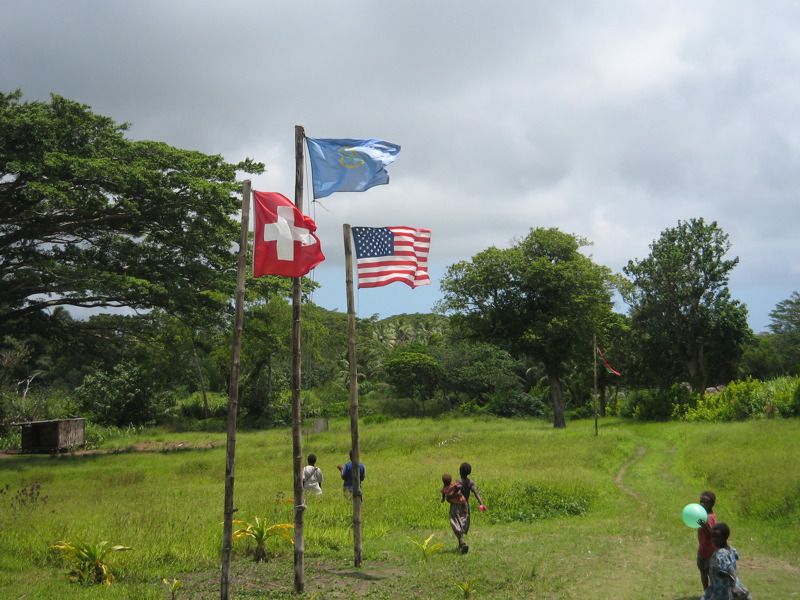Picture this: the second World War is unleashing upon the world, but in a far corner across the seas from America, patches of land remain untouched by its wrath. In a paradisiacal world near Australia, tribal natives go about their lives surrounded by glorious waves and lush greenery. Devoid of material treasures of modern civilisation, their life goes on oblivious to the greed that strangles the rest of the world. That, until one day, curious-looking machines bring in uniformed men that change these islanders forever.

Ceremonial cross of John Frum cargo cult, Tanna island, Vanuatu. Photo: Tim Ross/Wikimedia
Cargo cults were these tribes of native islanders who attributed the immense wealth and power of the whites to magic. As planes and ships, radios and televisions made their way onto these islands, they were left so stunned that there seemed no better explanation to justify their mingling. In the true sense of the term, 'cargo' referred to goods and products, which the cults believed were created by divine forces.
The first use of the term appeared in the 1945 issue of the colonial news magazine Pacific Islands Monthly Now, attributing the post-war culture to misleading religious teaching. The prophecy varied across movements, but a central theme remained that an ancestor had probably travelled to the west long ago and had learnt the tricks of cargo production there. They had then shipped the goods back home, which the foreigners had acquired on the way.
The exposure thus inspired the desire to gain back what was rightfully theirs. While industrialisation was spurting in the 20th century west, these islanders were imitating western progress by replicating its goods. They made radios from wood and planes from straws, thinking they could get the same effects. They were chasing progress without applying the same principles—an approach that earned them the name of cargo cults.

John Frum cargo cult and their ceremonial flag raising. Photo: Charmaine Tham/Wikimedia
Members of these cults also began performing white behaviours in ritualistic ceremonies in the hopes that the divine will one day recognise them and give them what currently rested with the whites. Cargo worship became a religion, seen at its brightest and earliest across Melanesia, which is a ground of island nations stacked between Australia and the Pacific Ocean. Frenzy thus sprung up across the region in the form of the taro cult of New Guinea, the vailala madness of Papua, the naked cult of Espiritu Santo, the tuka cult of the Fiji Islands and many more. What was central in all these movements was the belief that new cargo would herald a new age. Another religious cult worshipped King George V of England as God.
Around 184 cultus have been identified across the region; only a few survive still. While some believe in the return of their ancestors, others continue to wait for the foreigners themselves to bring the revered goods back home. They created landing strips, docking bays and other infrastructure to make it easier for them to reach the isolated islands. A popular example of this is the John Frum movement that is popular among the students of Vanuatu–a tiny Y-shaped archipelago near the Fiji Islands. Every year on John Frum day, thousands of devotees celebrate the American messiah John Frum, who is believed to have appeared on the lands in the 1800s and promised to bring back western goods for the locals if they prayed for them. They sit waiting for radios, TVs, medicines, cold drinks and more. But since the war, barely any Americans have come back, and John Frum, not even then.
Many scholars suggest, based on such narratives, that cargo cults began existing way back in the 19th century. So when during the second World War westerners arrived, they brought with them the first confirmation of these outrageous beliefs. Strangers were finally dropping from the sky with exotic looking artifacts, just as they had prophesied.
These beliefs were rooted as much in Christian beliefs as in native rituals. Local tribesmen worshipped deities with the belief that they would send new cargo to the land from heaven. Some cults expected that the cargo would arrive from Australia, or the sky above it. In this theory, heaven was a place connected to earth by a ladder. Also central to these practices was economic backwardness, cultural oppression and a new-found greed. Naturally, when new age goods arrived with the whites, these ignorant tribes celebrated the end of dearth. So what if the cargo was never meant for or shared with them?
References
# Smithsonian Magazine
# Scientific American
# Anthro Encyclopedia
# Air Force Magazine












> ... misleading religious teaching.
ReplyDeleteIs there any other kind?